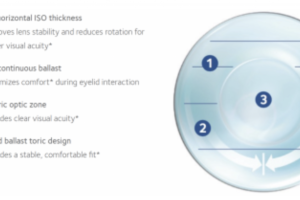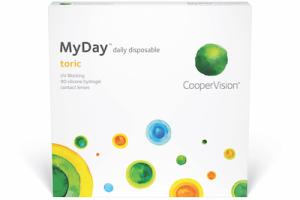
It’s estimated that 50% of individuals have astigmatism of 0.75D or greater in at least one eye.1 However, only 30% of contact lenses are prescribed for astigmatism.2 Further, the International Contact Lens Prescribing in 2022 report cites that toric designs account for only 28% of soft lens fits globally.3
Doing a simple math calculation, it’s easy to see the gap-but more so the opportunity-for eye care professionals (ECPs) to fit patients with astigmatism into toric contact lenses.
Looking at the current landscape, today’s soft torics have made significant advances when it comes to ease of fit, comfort, rotational stability, and vision.4 Additionally, modern torics are available in a wide range of parameters, wearing schedules, and designs, allowing for greater opportunities for successful fits in a wide range of patients.4
Dr. Ian Whipple, OD, of Vision Source of Farr West, Utah, and a 2019 CooperVision Best Practices Honoree, shares insight on:
How ECPs can expand the toric arm of their contact lens practice and how astigmatic patients can benefit from modern day toric designs.
Avoid “Masking” Low Levels of Astigmatism
Studies have found that uncorrected astigmatism, even at low levels, can cause decreased vision.5-8 For example, 1.00 D of uncorrected astigmatism can result in a significant decrease in distance and near visual acuity, in addition to reading speed, with low levels (1.00 DC) of induced astigmatism also decreasing reading fluency, and stereoacuity.6-8 From a patient’s perspective, adequately correcting their astigmatism is the priority to provide them clear vision.9
Spherical and aspheric lenses don’t adequately “mask” corneal astigmatism,5 and with today’s modern toric designs, there is no need to mask cylinder with spherical contact lenses, as they don’t result in the best visual outcome, Dr. Whipple says.
“I don’t know why some patients with low levels of astigmatism are still being fit with spherical equivalent lenses to ‘mask’ their astigmatism, especially when we’ve got modern torics that work. It’s like living in the past. A 15-year-old cellphone isn’t the same as an iPhone. Arguably, a 15-year-old cellphone can still make a phone call, but it’s not the same device.”
With contemporary toric lens options, ECPs can fit even low levels of astigmatism reliably and comfortably because of the stability and reproducibility of the designs.10
Dr. Whipple adds, “15 years ago, we had torics that weren’t centering very well and were inconsistent. I understand, maybe you would fit a low astigmat in a spherical equivalent back then based on the technology we had, but with today’s modern toric designs, there’s no reason not to fit a patient with low astigmatism into a toric lens.”
Numerous studies have compared visual performance of spherical contact lenses vs. toric lenses. One investigation found patients with astigmatism who were previous spherical contact lens wearers gained superior visual acuity when refit in toric soft lenses.11 Other studies came to the same conclusion and found, when compared with spherical lenses, patients with astigmatism who were fit in toric lens designs had noted improvements in their subjective and objective visual performance.12,13
Refit Previous Contact Lens Drop-outs in Modern Torics
Dr. Whipple not only has astigmatism, but he dropped out of toric contact lenses when he wore a previous generational design during college.
“I was wearing an older technology, and the lens rotated. It was thick and not very breathable,” he says. “Today, manufacturers have put in a lot of effort to try and create a better lens experience for patients with improved stability, vision and comfort. I know patients who tried toric contact lenses maybe 10 to15 years ago, and they weren’t happy. But I fit these same patients in a modern day toric, and they’re doing great.”
Recent studies suggest astigmatic patients who drop out of contact lens wear can have improved visual acuity when refit in a modern day soft toric lens.11 One investigation by Sulley, et. al., included 200 participants: 72 contact lens drop-outs; 67 spherical soft contact lens wearers; and 61 neophytes.11 The researchers found that previous contact lens drop-outs, along with the neophyte wearers, achieved visual acuity comparable to spectacles when fit with toric soft lenses.11
Make Your Communication Easy and Understandable in the Exam Room
Dr. Whipple finds that many patients lack a clear understanding of astigmatism and often express greater concerned with the diagnosis than if he told them they had dry eye, blepharitis, or were at risk for age-related macular degeneration.
“In many cases, patients are familiar with the term ‘astigmatism,’ but it sounds scary to them.”
In order to take the next step in prescribing toric contacts lenses, it’s important to come up with an easily understandable explanation about the condition, he says. “I tell patients, ‘Two-thirds of everyone on the planet has astigmatism, and it means that your eye is physically shaped flatter in one direction and is curvier in the other, and that it’s not a disease, but refers to the shape of your eye.’ Then I say, ‘Thank goodness, we have contact lenses and treatments to correct it.’”
Parameter Expansions Mean Greater Wearing Opportunities
CooperVision recently broadened its parameter range for MyDay® toric, which expanded its current range by nearly 70% and matched the industry-leading range of Biofinity® toric.14
“CooperVision has a great parameter range of lenses with the most available options for us,"15 Dr. Whipple says. “I love that the Biofinity® and MyDay® toric parameter ranges are so huge. I can fit a vast majority of astigmats in either of those two lenses.”16,17
With the expanded parameter ranges, even more patients with astigmatism have the opportunity to wear contact lenses.
“When I talk to patients, I don’t give them the choice of whether we’re going to correct their astigmatism or not. If I’m prescribing a contact lens for an astigmatic patient, I’m going to prescribe a toric lens,” Dr. Whipple says. “If the patient wants to wear contact lenses, and they have astigmatism, I tell them that we need to put the correction into the contact lens to get the best results, and it doesn’t matter if it’s a low amount or a high amount of astigmatism. And now we have the ranges to accommodate them.”

Manufacturer Tools Make for Easy Fits
No matter where an ECP is in their toric contact lens fitting experience, tools are available to help with a seamless fit, including the OptiExpert® Contact Lens Calculator, which can save valuable chair time by accurately recommending CooperVision toric powers.18
“If a doctor is wondering what parameters are available, they can input the patient’s prescription and find out immediately. With OptiExpert®, I don’t need to look at Tyler’s Quarterly or ODspecs, I can have my tech pull up the available parameters for patients and get the information right away.”
Final Thoughts
For his colleagues who are still hesitant to fit modern day toric lenses, Dr. Whipple’s advice is, don’t be afraid to jump in and put a lens on the eye.
“Astigmatism needs to be corrected in a contact lens,” Dr. Whipple says. “We owe it to the patient to give them the best vision possible. There may be rare times when a spherical equivalent will work just fine, but I don’t think that’s very often. I always reach for the toric lens first, and I’d challenge other doctors to do the same. I think we owe it to our patients.”






